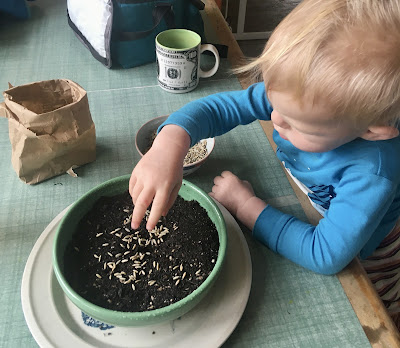Agenda this week:
1. Spring cleaning
2. Plant the sabzeh
3. Welcome the angels
4. Offer thanks
5. Recite prayers
3. Welcome the angels
4. Offer thanks
5. Recite prayers
1. Spring cleaning:
To honor the angels, and prepare for Nowruz, Iranians clean their houses, mend anything that is broken, take baths, and buy new clothes.
In January I cleaned mold and mildew. In February I cleared clutter. In March I take the first steps of spring cleaning and maintenance, those big jobs that get put off through the winter months. This week my focus is in the kitchen - cleaning the oven, clearing out the refrigerator and freezer, and cleaning the windows outside and in.
5. Plant a sabzeh:
The sabzeh is a bowl of sprouted grains, a symbol of new life, that are planted before Nowruz. Since I forgot to start the sabzeh last week (it really takes 2 weeks to get good looking sprouts), we will do that today.
Supplies: A shallow bowl, damp soil, grain seeds (lentils and wheat are traditional; we planted hull-less rye grain).
Fill the bowl with damp soil, cover the surface well with seeds, and spray daily with water.
2. Welcome the angels:
 After the house is clean, Zoroastrian families set out fresh flowers and light an oil lamp to welcome their ancestors and the Fravashis.
After the house is clean, Zoroastrian families set out fresh flowers and light an oil lamp to welcome their ancestors and the Fravashis.
This is like All Souls Day, when souls come down to the earth -- a joyful time for remembering and welcoming the souls of departed ancestors and all angels. The water and flowers in the vase are the symbolic reminders of the invisible souls and Fravashis, and are supposed to be changed daily for the next 10 days. The lamp is kept lit all the time (I use a candle, and keep it lit only when I'm nearby).
3. Offer thanks:
People mostly stay home during these days before Nowruz, since the souls and Fravashis come home, and it is not proper to leave them and go out. Sometimes people keep a night long vigil.
It's also interesting to note that the Zoroastrians celebrate the last day of the year (March 20th) as the Day of Repentance, to ask Forgiveness from the Fravashis... much like the Orthodox Christian Forgiveness Sunday at the start of Lent.
The Ashem Vohu is a prayer with universal appeal. The word Ashem has many meanings: Law, Order, Beauty, Truth, Righteousness, Purity, Freedom. This one word expresses Divine truth, purity of body and mind, and all the beauty of nature. It's a central idea in Zoroastrianism.
 After the house is clean, Zoroastrian families set out fresh flowers and light an oil lamp to welcome their ancestors and the Fravashis.
After the house is clean, Zoroastrian families set out fresh flowers and light an oil lamp to welcome their ancestors and the Fravashis. This is like All Souls Day, when souls come down to the earth -- a joyful time for remembering and welcoming the souls of departed ancestors and all angels. The water and flowers in the vase are the symbolic reminders of the invisible souls and Fravashis, and are supposed to be changed daily for the next 10 days. The lamp is kept lit all the time (I use a candle, and keep it lit only when I'm nearby).
3. Offer thanks:
During this festival, Zoroastrians show love and gratitude to the Fravashis, for all the help they give during the year. The Fravashis help waters to flow, plants to grow, clouds to go where needed and the sun, moon and planets to go around in their orbits. They uphold the sky and earth. Every creation has a Fravashi, and human beings have individual Fravashis as our guardian spirits.
This is also a time to show gratitude to one's ancestors - those whom we know and the countless others whom we don’t know, but who have made a difference to our lives.
People mostly stay home during these days before Nowruz, since the souls and Fravashis come home, and it is not proper to leave them and go out. Sometimes people keep a night long vigil.
It's also interesting to note that the Zoroastrians celebrate the last day of the year (March 20th) as the Day of Repentance, to ask Forgiveness from the Fravashis... much like the Orthodox Christian Forgiveness Sunday at the start of Lent.
4. Recite Prayers:
People say lots of prayers during these ten days. Zoroastrians turn towards a flame while praying, which symbolizes the fire of creation and the spiritual flame within each of us-- and so I stand before a candle flame to recite the Ashem Vohu (invocation of Asha) from the Avesta (Zoroastrian Book of Common Prayer).
This prayer is like a mantra, to be chanted slowly. To hear it recited, go to this link.
ashem vohû vahishtem astî
Truth is the best good.
ushtâ astî
It is happiness.
ushtâ ahmâi hyat ashâi vahishtâi ashem.
Happiness is to one whose truth (represents) best truth.


No comments:
Post a Comment